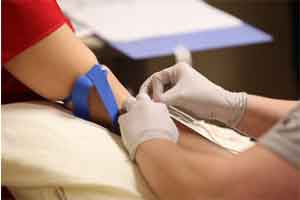- Home
- Editorial
- News
- Practice Guidelines
- Anesthesiology Guidelines
- Cancer Guidelines
- Cardiac Sciences Guidelines
- Critical Care Guidelines
- Dentistry Guidelines
- Dermatology Guidelines
- Diabetes and Endo Guidelines
- Diagnostics Guidelines
- ENT Guidelines
- Featured Practice Guidelines
- Gastroenterology Guidelines
- Geriatrics Guidelines
- Medicine Guidelines
- Nephrology Guidelines
- Neurosciences Guidelines
- Obs and Gynae Guidelines
- Ophthalmology Guidelines
- Orthopaedics Guidelines
- Paediatrics Guidelines
- Psychiatry Guidelines
- Pulmonology Guidelines
- Radiology Guidelines
- Surgery Guidelines
- Urology Guidelines
With new device with acoustic cell-sorting no need to send blood samples to lab

A prototype device developed by an international team of engineers can shift exceedingly tiny particles from blood samples without having to send samples off to a lab. The device, which combines acoustic cell-sorting and microfluidic technologies, could be a boon to both scientific research and medical applications.
The system is optimized to sort out "exosomes," biological nanoparticles released from every type of cell in the body. Thought to play a large role in cell-to-cell communication and disease transmission, they have been objects of scientific curiosity since their discovery three decades ago.
The miniscule size of exosomes, however, makes them difficult to study and challenging to separate from their native biological fluids. Current practices involve spinning samples in a centrifuge for several hours or even days, often damaging the exosomes by subjecting them to extremely high gravitational forces. Even then, the procedure only captures a small fraction of the nanoparticles present in the biological fluid.
In a paper appearing the week of Sept. 18 in the Proceedings of the National Academy of Sciences, researchers from Duke University, the University of Pittsburgh and Magee Womens Research Institute, the Massachusetts Institute of Technology and Nanyang Technological University Singapore, demonstrate a better method based on "acoustofluidics," a combination of acoustics and microfluidics.
The prototype device provides a gentle, automated, point-of-care system that allows single-step, on-chip isolation of exosomes from whole biological fluids with a high rate of purity and yield.
The results could help researchers and clinicians learn more about exosomes and form the foundation for diagnostic or therapeutic devices. The device may enable diagnosis and monitoring of many conditions with a simple blood draw and 'liquid biopsy,' including cancer, concussions and diseases affecting the brain, kidney, liver and placenta.
"Exosomes have significant potential in medical diagnosis and treatment, but the current technologies for exosome isolation suffer from drawbacks such as long turnaround time, inconsistency, low yield, contamination and uncertain exosome integrity," said Tony Jun Huang, professor of mechanical engineering and materials science at Duke. "This work offers a new technique that can address these issues. We want to make extracting high-quality exosomes as simple as pushing a button and getting the desired samples within 10 minutes."
"The capability of this method to separate exosomes without altering their biological or physical characteristics potentially offers new pathways to assess human health as well as the onset and progression of diseases," said Subra Suresh, co-corresponding author of the paper and president-designate of Nanyang Technological University Singapore, the 21st Century Professor of Biomechanics in Medicine at the University of Pittsburgh Medical School, and former president of Carnegie Mellon University.
The prototype device built by Huang and his colleagues creates a high-frequency sound wave traveling at an angle to liquid flowing down a tiny tube. By carefully tailoring the angle and frequency of the sound wave to the length of the channel and size of the particles, they can push any particle bigger than 1,000 nanometers into a separate channel.
This removes elements of blood such as white blood cells, red blood cells and platelets. The fluid then goes through a second chamber, where the same force is used to filter out everything smaller than 130 nanometers, which is about the size of most exosomes and 500 times smaller than the thickness of the human hair.
The dual-stage technique showed the ability to separate more than 80 percent of exosomes present with a purity of 98 percent, compared to current methods that capture only 5 to 40 percent of exosomes.
"The new device can eliminate all blood cells and platelets first before efficiently separating extracellular vesicles such as exosomes," explained Ming Dao, director of the Nanomechanics Laboratory at MIT. "This new generation of integrated device design makes it possible for centrifugation-free sorting of different blood components, which can drastically reduce the cost and processing time involved with liquid biopsy assays."
"This will add a new dimension to research into 'liquid biopsies' and facilitate the clinical use of extracellular vesicles to inform the physiology and health of organs that are hard to access, such as the placenta during human pregnancy," said Yoel Sadovsky, director of the Magee-Womens Research Institute at the University of Pittsburgh. "While using exosomes for these purposes is not yet proven, that is the promise of our research."

Disclaimer: This site is primarily intended for healthcare professionals. Any content/information on this website does not replace the advice of medical and/or health professionals and should not be construed as medical/diagnostic advice/endorsement or prescription. Use of this site is subject to our terms of use, privacy policy, advertisement policy. © 2020 Minerva Medical Treatment Pvt Ltd